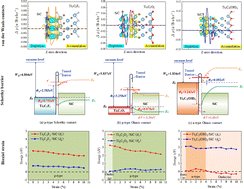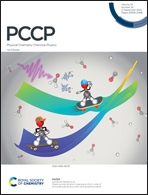Modulating the Schottky barrier of MXenes/2D SiC contacts via functional groups and biaxial strain: a first-principles study†
Abstract
Two-dimensional (2D) graphene-like SiC has attracted intense interest recently due to its unique electrical and physical properties. In implementing 2D semiconductors in device applications, one of the main challenges so far has been the formation of a high-quality Schottky barrier owing to the strong Fermi level pinning (FLP) at the interface of traditional metal–2D semiconductor contacts. In this paper, the 2D MXenes Ti3C2T2 (T = F, O, OH) are proposed to serve as electrodes for 2D SiC. The structural and barrier properties of the Ti3C2T2/SiC contacts were systematically investigated based on first-principles calculations combined with the GGA-PBE and HSE06 functionals. It is found that Ti3C2T2 can be bonded with 2D SiC by van der Waals (vdW) interactions. Weak FLP is exhibited at Ti3C2T2/SiC vdW contacts. The type of contact can be tuned by changing the functional T group of Ti3C2T2. Ti3C2F2/SiC and Ti3C2O2/SiC contacts exhibit a p-type Schottky contact and p-type Ohmic contact, respectively, whereas an n-type Ohmic contact occurs in the Ti3C2(OH)2/SiC contact. In addition, the calculated tunneling possibility (TB) is ∼20% between Ti3C2T2 and SiC, indicating weak bonding at the Ti3C2T2/SiC vdW junctions. Furthermore, the Schottky barrier height and TB of the Ti3C2(OH)2/SiC contacts can be modulated via the biaxial strain. The controllable contact type and barrier in Ti3C2T2/SiC contacts provide guidelines for developing high-performance 2D SiC optoelectronic and electronic devices.

- This article is part of the themed collection: 2022 PCCP HOT Articles


 Please wait while we load your content...
Please wait while we load your content...